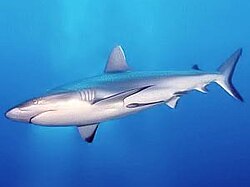Portal:Sharks
Welcome to the shark portal

Sharks are a group of elasmobranch cartilaginous fishes characterized by a ribless endoskeleton, dermal denticles, five to seven gill slits on each side, and pectoral fins that are not fused to the head. Modern sharks are classified within the division Selachii[page needed] and are the sister group to the Batomorphi (rays and skates). Some sources extend the term "shark" as an informal category including extinct members of Chondrichthyes (cartilaginous fish) with a shark-like morphology, such as hybodonts. Shark-like chondrichthyans such as Cladoselache and Doliodus first appeared in the Devonian Period (419–359 million years), though some fossilized chondrichthyan-like scales are as old as the Late Ordovician (458–444 million years ago). The earliest confirmed modern sharks (Selachii) are known from the Early Jurassic around 200 million years ago, with the oldest known member being Agaleus, though records of true sharks may extend back as far as the Permian.
Sharks range in size from the small dwarf lanternshark (Etmopterus perryi), a deep sea species that is only 17 centimetres (6.7 in) in length, to the whale shark (Rhincodon typus), the largest fish in the world, which reaches approximately 12 metres (40 ft) in length. They are found in all seas and are common to depths up to 2,000 metres (6,600 ft). They generally do not live in freshwater, although there are a few known exceptions, such as the bull shark and the river sharks, which can be found in both seawater and freshwater, and the Ganges shark, which lives only in freshwater. Sharks have a covering of placoid scales (denticles) that protects the skin from damage and parasites in addition to improving their fluid dynamics. They have numerous sets of replaceable teeth.
Several shark species are apex predators, which are organisms that are at the top of their food chain with select examples including the bull shark, tiger shark, great white shark, mako sharks, thresher sharks and hammerhead sharks. Some sharks are filter-feeding planktivores, such as the whale shark and basking shark, which are among the largest fish ever lived. (Full article...)
Selected article -
With a sizable oil-filled liver to maintain neutral buoyancy, the kitefin shark is able to cruise slowly through the water while expending little energy. Armed with large teeth and a strong bite, it is a powerful, solitary predator that takes many different types of prey, ranging from bony fishes, sharks and rays, to cephalopods, crustaceans, polychaete worms, siphonophores, and possibly carrion. It also takes bites out of animals larger than itself, similar to its smaller relative, the cookiecutter shark (Isistius brasiliensis). This shark is ovoviviparous and gives birth to 10–14 young. The kitefin shark is fished commercially for its meat, skin, and liver oil, primarily by Portugal and Japan. A fishery targeting this species existed off the Azores from the 1970s to the 1990s, but collapsed due to overfishing and falling liver oil prices; the rapid depletion of the Azores stock is often cited as an example of the susceptibility of deep-sea sharks to human exploitation. The World Conservation Union does not yet have sufficient data to assess the global conservation status of this species.
Did you know (auto-generated)

- ... that a shark cost a competitor a silver medal in the spearfishing event at the 2014 Micronesian Games?
- ... that the parasitic copepod Driocephalus cerebrinoxius burrows into the brains of sharks through their noses?
- ... that Hixxy and Sharkey created a schism in the UK rave music scene in 1995?
Categories
Related portals
WikiProjects
Selected picture -

More Did you know? -
- ... that the Portuguese dogfish is the deepest-living shark known, found as far down as 3,675 m (2.284 mi)?
- ... that the single known specimen of the Irrawaddy river shark was generally dismissed as an abnormal bull shark until 2005?
- ... that the green lanternshark often preys on squid and octopus much larger than itself, which it may overwhelm by attacking in packs?
- ... that the barbeled houndshark is the only shark with a spherical placenta?
- ... that the cookiecutter shark may use the absence of bioluminescence to attract prey?
General images
Topics
For additional lists of marine life-related featured articles and good articles see:
Wikimedia
The following Wikimedia Foundation sister projects provide more on this subject:
-
Commons
Free media repository -
Wikibooks
Free textbooks and manuals -
Wikidata
Free knowledge base -
Wikinews
Free-content news -
Wikiquote
Collection of quotations -
Wikisource
Free-content library -
Wikispecies
Directory of species -
Wikiversity
Free learning tools -
Wiktionary
Dictionary and thesaurus






































